Homemade Chili Seasoning: Crafting the Best Spice Blend for Your Perfect Chili
After countless bowls of chili and years of passionate experimentation, we’ve finally perfected a homemade chili seasoning mix that consistently transforms our chili into a cherished family favorite. While the definition of the “best chili recipe” is undoubtedly a matter of personal taste, we are confident that this meticulously crafted blend will earn a top spot in your recipe collection. Forget those bland store-bought packets; our DIY chili seasoning empowers you to create deeply flavorful, perfectly spiced chili every single time, tailored exactly to your preference.

The Journey to My Signature DIY Chili Seasoning
For a long time, my approach to making chili was more art than science. I would simply toss ingredients into a large pot, tasting and adjusting as I went, until I reached a flavor I was happy with. There wasn’t a formal “recipe” to speak of, especially when it came to the spices.
Like many home cooks, I grew up with my mom relying on McCormick Chili Seasoning packets. I followed suit for years, finding comfort in their convenience. However, one day, I found myself without a packet, yet with a strong craving for chili. Instead of running to the store, I decided to “wing it.” This unexpected moment became the catalyst for a flavorful journey. I began experimenting with individual spices, meticulously tweaking proportions until I landed on this perfect homemade chili spice mix. It’s a blend I’ve used ever since, and it has undeniably elevated our family’s chili nights.
Crafting your own chili seasoning from scratch offers immense advantages. You gain complete control over the quality and freshness of your ingredients, ensuring your chili tastes vibrant and authentic. Furthermore, you can avoid unwanted additives, excessive sodium, or artificial flavors often found in pre-made mixes. This DIY approach isn’t just about saving a trip to the grocery store; it’s about unlocking a new level of customization and culinary satisfaction, allowing you to fine-tune the heat, depth, and overall character of your chili. It’s an empowering step towards becoming a true chili master.

How Do You Prefer Your Chili? The Art of Customization
Chili is one of those dishes where personal preferences reign supreme. People have very strong opinions about how they like their chili, and rightly so! Are you a fan of fiery heat, or do you prefer a milder, comforting warmth? Do you insist on plenty of meat, or do you gravitate towards a vegetarian version? And, perhaps the most debated question of all: beans or no beans?
The beauty of a homemade chili seasoning blend lies in its adaptability. My personal go-to is my Three Bean Chili Recipe, which forms the perfect canvas for this versatile spice mix. This blend is designed to be easily adjustable. For those who “can’t take the heat,” you can simply reduce or omit the cayenne pepper and red pepper flakes. Conversely, if you’re like me and prefer your chili with a kick, feel free to be generous with the cayenne and add extra red pepper flakes. This flexibility ensures that everyone, from the spice enthusiast to the sensitive palate, can enjoy a bowl of perfectly seasoned chili.
Consider the myriad ways chili is prepared across different regions. Texas chili, for instance, is famously meat-heavy and bean-free, often relying on a robust blend of chili powders and minimal tomato. Cincinnati chili is known for its unique Mediterranean spices like cinnamon and chocolate, served over spaghetti with an array of toppings. Midwestern chilis often feature ground beef and beans in a thick, tomato-based sauce, emphasizing heartiness. No matter your regional preference or dietary choice—whether you opt for beef, turkey, chicken, or a plant-based alternative—a well-balanced homemade chili spice mix is the absolute foundation for an outstanding bowl. It allows you to control the very essence of your chili’s flavor profile.
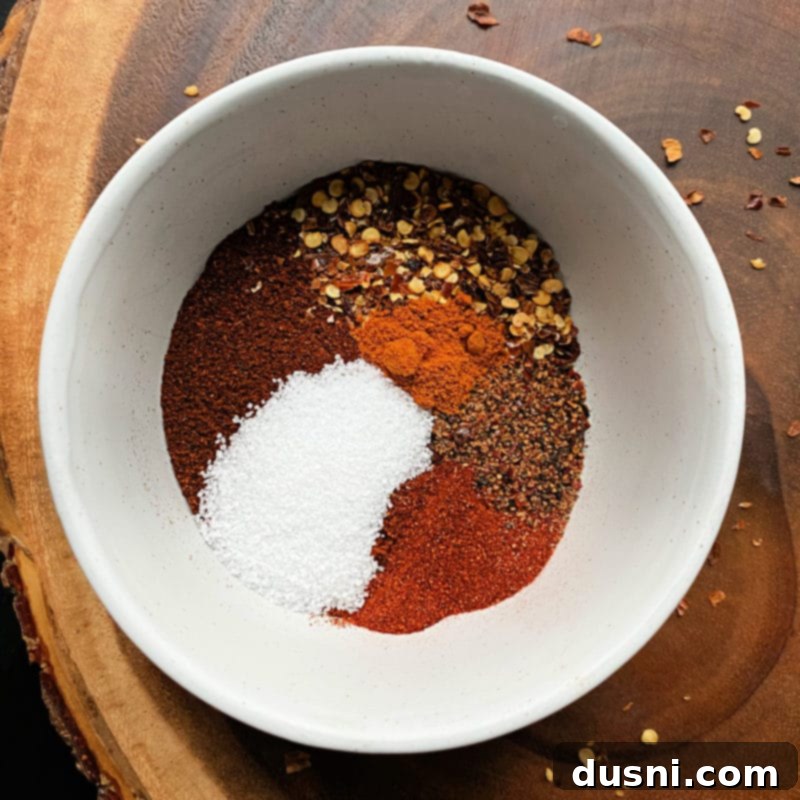
Understanding the Core Spices for Chili
When crafting the perfect chili seasoning, certain ingredients are universally recognized as essential building blocks. The most common spices found in a classic chili seasoning recipe typically include chili powder, paprika, garlic powder, onion powder, red pepper flakes, cayenne pepper, and cumin. Each plays a crucial role in developing the complex, savory profile we associate with great chili.
Chili Powder: More Than Just One Spice
Many newcomers to chili making might wonder if “chili powder” is a seasoning in itself. While chili powder is undeniably the cornerstone ingredient in any chili blend, it’s actually a mix of several spices, often including ground chiles (like ancho, pasilla, or New Mexico chiles), cumin, garlic, and oregano. So, while it provides the primary chili flavor, the other ingredients in a DIY seasoning mix are vital for adding depth, balance, and that signature “flavor punch” that elevates your dish beyond a simple chile heat.
The Power of Individual Spices in Your Chili Blend:
- Chili Powder: The foundation. This blend of ground chiles, cumin, garlic, and oregano provides a robust, earthy, and mildly spicy base. The quality of your chili powder significantly impacts the overall flavor of your homemade chili seasoning.
- Paprika: Adds vibrant color and a subtle sweetness. Depending on the variety, it can also introduce a mild smoky note (smoked paprika) or a touch of heat (hot paprika), beautifully complementing the chili powder.
- Garlic Powder & Onion Powder: These provide concentrated, savory aromatics that are critical for depth of flavor. While fresh garlic and onion are often used as well, their powdered counterparts ensure a consistent background flavor throughout the dish.
- Red Pepper Flakes: Offer a direct, vibrant heat that tingles on the tongue. The visible flakes also add a rustic aesthetic, letting diners know a little kick is coming.
- Cayenne Pepper: The primary source of intense, straightforward heat. A small amount can dramatically increase the spice level, making it easy to customize your chili’s fiery intensity.
- Cumin: Imparts a distinctive earthy, warm, and slightly pungent flavor that is quintessential to many chili recipes. It’s a powerful spice, and its use is often debated – too little, and chili lacks depth; too much, and it can become overwhelming.
Beyond these staples, some chili enthusiasts venture into adding “secret ingredients” to their recipes, claiming these unique additions are what truly make their chili stand out. You might be surprised to hear about ingredients like unsweetened chocolate or cocoa powder (which deepens color and adds a rich, subtle bitterness), cinnamon (for a warm, aromatic complexity, especially popular in some regional chilis), cornmeal (to thicken and add a hearty texture), or even beer, cola, or wine (to tenderize meat and add layers of nuanced flavor). While these additions are entirely optional, they demonstrate the creative freedom that comes with crafting your own chili blend and exploring unique flavor dimensions.
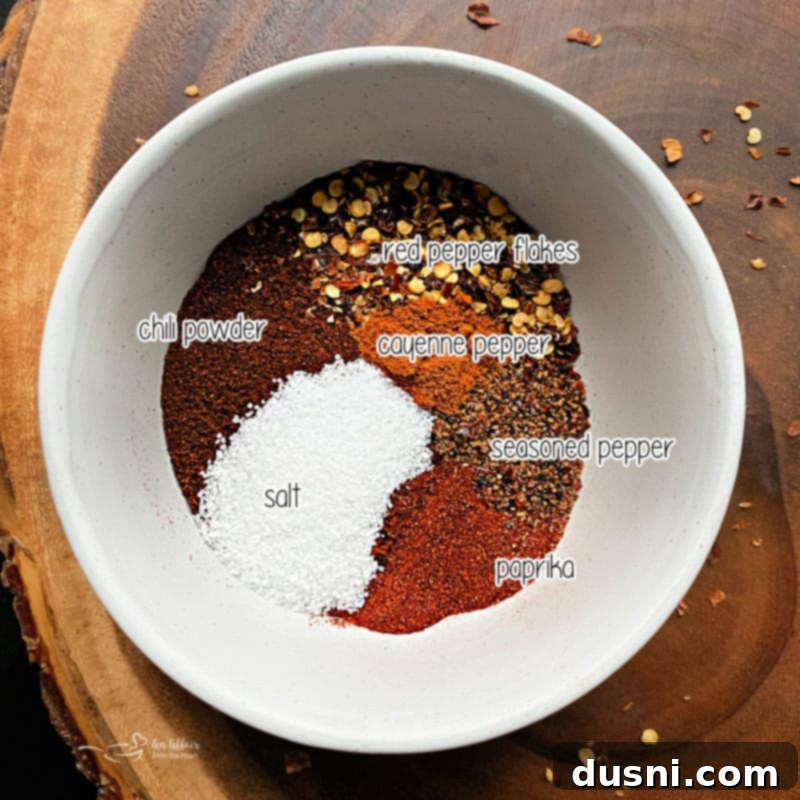
Unveiling My Ultimate Homemade Chili Seasoning Blend
After much trial and error, my personal chili seasoning recipe incorporates many of the common spices mentioned above, with a few intentional adjustments that define its unique character. My goal was to create a blend that is robust, flavorful, and versatile, without overpowering the other ingredients in the chili, allowing the rich flavors of your meat and beans (if using) to shine.
One notable exception in my standard blend is cumin. While it’s a popular chili spice, I’ve found that I can sometimes be a little too heavy-handed with it, leading to a “taco seasoning flavor” that can quickly dominate the chili. Don’t get me wrong, I love cumin, but for my specific chili profile, I prefer a more subtle presence that doesn’t scream “taco night.” If you’re a cumin lover, feel free to add a touch to your mix, but I recommend proceeding lightly. Start with a quarter or half teaspoon for a full pot, and you can always add more later if you feel it needs that extra earthy note, tasting as you go.
Another conscious choice I make is to omit garlic powder and onion powder from my dry spice mix. This is purely a matter of preference and technique; I always use fresh garlic and onion when browning my ground beef (or sautéing vegetables for a vegetarian version). I believe that fresh aromatics contribute a deeper, more vibrant flavor and a heartier texture to the chili that powdered versions simply can’t replicate. The slow sautéing of fresh onions until translucent and the gentle cooking of minced garlic releases their sugars and essential oils, building a foundational layer of flavor that powdered spices complement rather than replace. If fresh isn’t an option for you, don’t worry – the recipe notes include adjustments for adding powdered versions to the mix!
So, what exactly is in my tried-and-true homemade chili spice blend? It’s a harmonious mix of:
- Salt: Essential for enhancing all other flavors and bringing them into balance.
- Seasoned Pepper: Adds a nuanced pepperiness that goes beyond simple black pepper, often containing a blend of spices like garlic, onion, and various peppers.
- Paprika: For rich color, a touch of sweetness, and a subtle earthy note that rounds out the spice profile.
- Cayenne Pepper: My preferred source for that delightful chili kick, adjustable to your personal heat tolerance.
- Chili Powder: The backbone, providing that classic chili flavor and a complex base.
- Red Pepper Flakes: For an extra layer of visible heat, a subtle textural element, and a slow-building warmth.
This carefully balanced blend ensures a rich, savory, and perfectly spiced chili that hits all the right notes without any single spice overpowering the others. It’s the secret behind our family’s consistently delicious chili, and I’m excited for it to become a staple in your kitchen too.
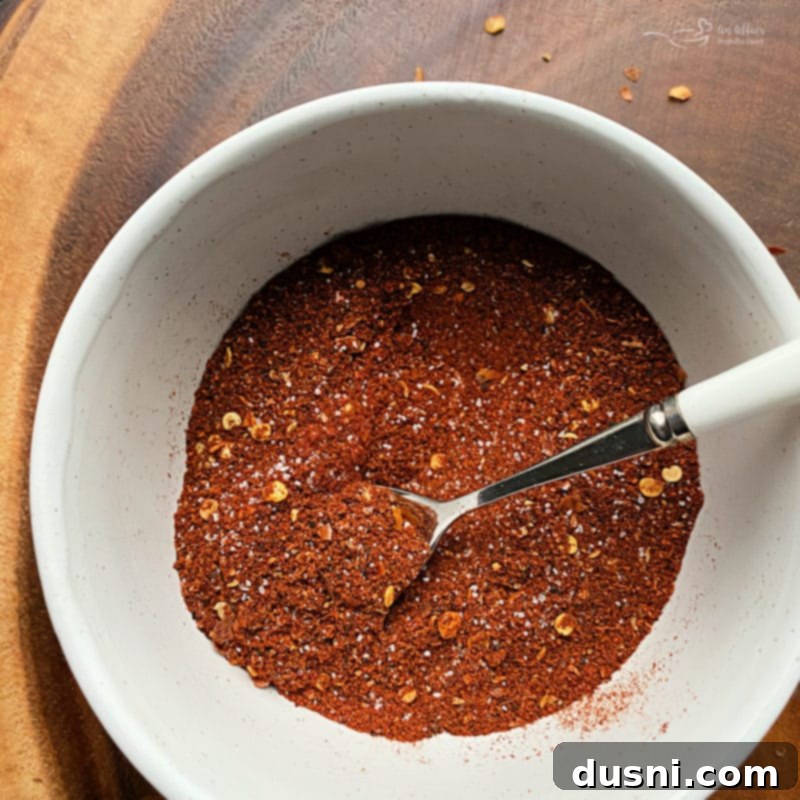
Mixing, Storing, and Using Your Homemade Blend
Once you’ve gathered all your spices, simply combine them thoroughly in a bowl. Whisk or stir until they are evenly distributed, ensuring every spoonful of your chili gets the full spectrum of flavor. This particular blend is perfectly portioned for one batch of my Three Bean Chili, which generously serves about 12 people – ideal for family gatherings, potlucks, or making a big batch for satisfying leftovers!
For convenience and efficiency, I highly recommend making a larger batch. In the notes section of the printable recipe card below, I’ve provided precise measurements for a quadruple batch. This way, you’ll always have your homemade chili seasoning ready to go whenever a chili craving strikes, cutting down on prep time significantly. Store your blend in an airtight container, such as a glass jar with a tight-fitting lid, in a cool, dark place away from direct sunlight and heat. This protects the delicate spice compounds from light, air, and moisture, preserving their potency and flavor for several months. While ground spices typically remain safe to consume indefinitely, they do lose their vibrancy and aromatic qualities over time, so using them within 3-6 months is ideal for optimal taste and maximum impact in your chili.
When it’s time to make your chili, incorporate the seasoning blend after browning your meat (if using) and sautéing your fresh aromatics. Adding the dry spices to the hot pan for about 30 seconds to a minute before adding liquids allows them to “bloom” or “toast” in the residual fat. This crucial step releases their essential oils and intensifies their flavors, creating a more complex and fragrant base for your chili. The aroma alone as the spices toast will make your kitchen smell absolutely incredible, building anticipation for the delicious meal to come!
Beyond Chili: Creative Uses for Your DIY Spice Mix
While this blend is specifically formulated to create the best chili you’ve ever tasted, its robust and versatile flavor profile makes it fantastic for many other dishes. Don’t let it sit idle in your pantry between chili nights! Here are a few creative ideas to put your homemade chili seasoning to good use:
- Meat Rub: Use it as a dry rub for various meats like beef (steaks, roasts, brisket), pork (ribs, chops, shoulder), or chicken (breasts, thighs, wings) before grilling, roasting, or slow cooking. It imparts a wonderful smoky and spicy crust.
- Roasted Vegetables: Toss potatoes, sweet potatoes, cauliflower florets, Brussels sprouts, or bell peppers with olive oil and a generous sprinkle of chili seasoning before roasting for an extra kick and depth of flavor.
- Seasoned Beans: Elevate simple canned black beans or pinto beans by stirring in a teaspoon or two of this mix while heating them. It makes for a quick and flavorful side dish for any Mexican-inspired meal.
- Taco & Fajita Seasoning: While it’s not a direct taco seasoning, it can certainly be used to season ground meat for tacos or sliced chicken and peppers for fajitas in a pinch. Adjust quantities to taste for your desired flavor intensity.
- Soups & Stews: Boost the flavor profile of other hearty soups or stews with a dash of this seasoning. It works particularly well in lentil soup, black bean soup, or even a simple vegetable broth.
- Dips & Spreads: Stir a small amount into sour cream, plain Greek yogurt, cream cheese, or guacamole for a zesty, spicy dip perfect for chips, vegetable sticks, or as a spread on sandwiches.
- Popcorn: For a savory, spicy snack, sprinkle lightly over freshly popped popcorn while it’s still warm, allowing the seasoning to adhere.
- Egg Dishes: A pinch added to scrambled eggs, omelets, or a breakfast burrito can add an exciting depth of flavor to your morning meal.
Experimenting with your homemade spice blend in different culinary contexts is a fantastic way to discover new favorite flavor combinations, broaden your cooking repertoire, and ensure no delicious spice goes to waste!
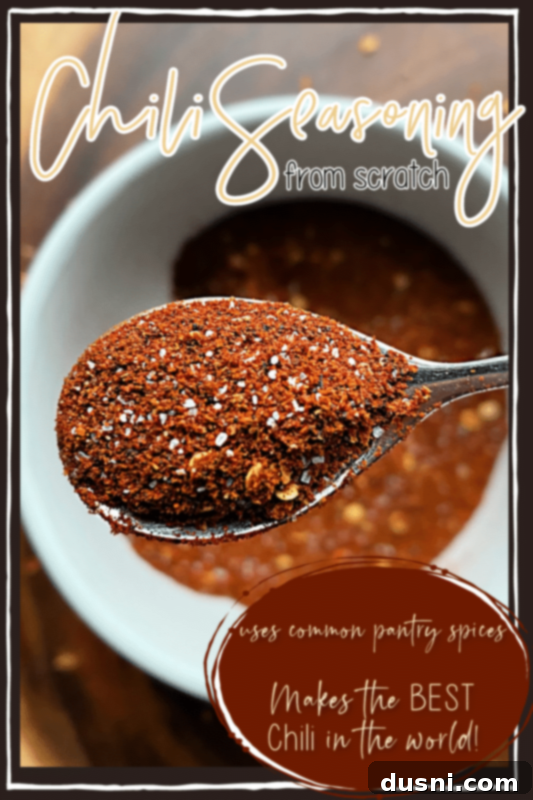
Love This Recipe? Pin It for Later!
Don’t let this incredible homemade chili seasoning recipe get lost in the shuffle! Make sure to save it to your favorite Pinterest recipe board so you can easily find it whenever you’re ready to whip up a batch of delicious, perfectly spiced chili. Your taste buds (and your family) will thank you!
Explore More Homemade Mixes and Spices:
- The BEST Homemade Pumpkin Pie Spice
- My Homemade Apple Pie Spice
- Make your own Bisquick Mix
- Homemade Taco Seasoning Mix
- Everything Bagel Spice from Scratch
- French Fry Seasoning
- Homemade Poultry Seasoning
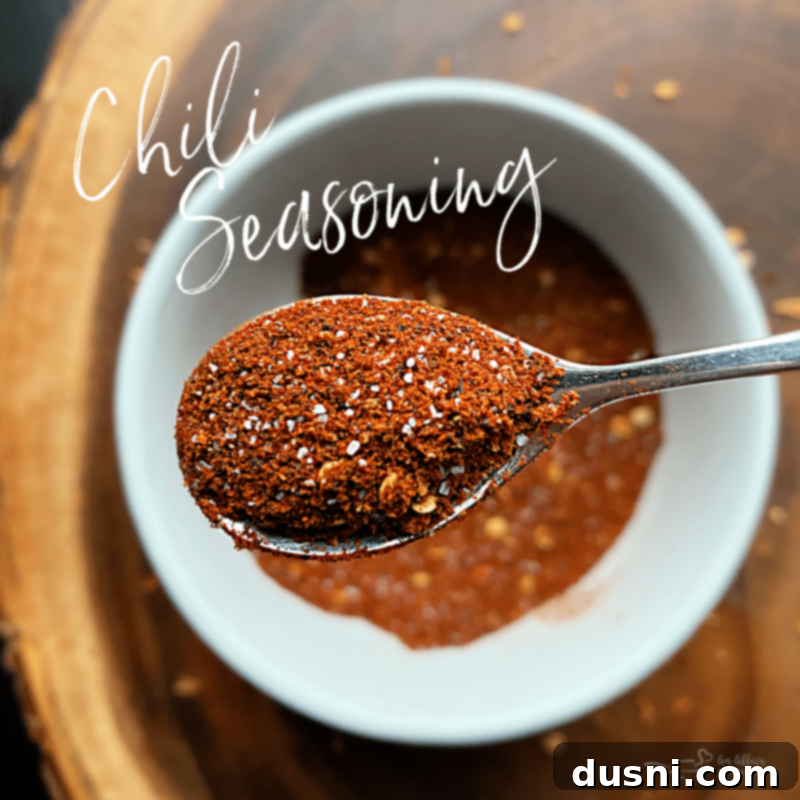
Ready to elevate your chili game with this simple yet incredibly effective Homemade Chili Seasoning? Scroll down to grab the full recipe and start creating your most flavorful, warming, and comforting chili yet! Happy cooking!

LIKE THIS RECIPE?
Don’t forget to give it a ⭐️⭐️⭐️⭐️⭐️ star rating and
leave a comment below the recipe!
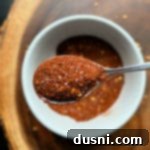
Print Recipe
Homemade Chili Seasoning Recipe
Ingredients
- 2 Tablespoons chili powder
- 1 teaspoon paprika
- 1 teaspoon red pepper flakes
- 1/2 teaspoon seasoned pepper
- 1 teaspoon salt
- 1/2 teaspoon cayenne pepper
Instructions
-
Combine everything together and store in an airtight container until ready to use, or place directly into chili soup.
Notes
Large Batch Measurements: 1/2 cup chili powder, 1/4 cup + 1 teaspoon of paprika, red pepper flakes, salt, and 2 teaspoons of seasoned pepper and cayenne. Store in an airtight container and use 3 heaping Tablespoons for a batch of chili. Makes 4 batches.
Nutrition
